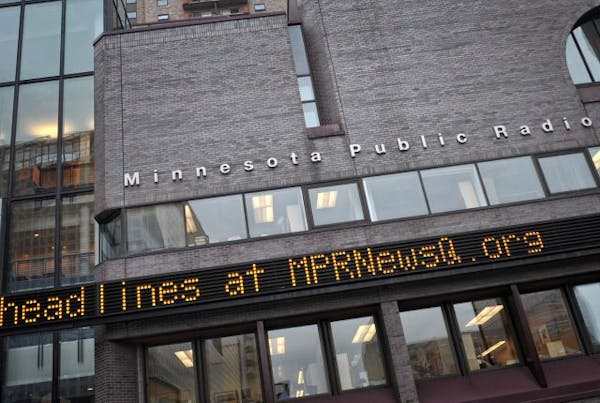Whether they're fired up or fed up by the Trump administration, Americans seem to agree on one thing: It's must-see TV.
In February, Fox News enjoyed a 31 percent ratings increase from a year ago as Megyn Kelly's replacement, Tucker Carlson, quickly established himself as a prime-time star. Liberal-leaning counterpart MSNBC was up 55 percent, thanks largely to "The Rachel Maddow Show," which has doubled its audience, an almost unheard of accomplishment for a 9-year-old program.
Over at C-Span, White House press secretary Sean Spicer's afternoon briefings are beating the soap operas in the ratings.
Just one segment of TV land hasn't benefited from the upswing in interest: the once-dominant broadcast networks, whose relatively evenhanded approach doesn't play to a sharply polarized public.
"There's an energy to this coverage that's not like anything I've ever experienced," said Lawrence O'Donnell, host of MSNBC's "The Last Word," which follows Maddow on weekday nights and has also seen a rise in ratings. "I can't tell you how long this will last because nobody predicted it in the first place."
After the November election, CNN President Jeff Zucker assumed viewers would want a respite from the political grind and braced his staff for a 20 percent drop in ratings. Instead, they shot up over 50 percent among 25- to 54-year-olds during the first two months of 2017.
"2016 was the biggest year in the history of cable news, and 2017 will perhaps be even bigger," Zucker told the Los Angeles Times. "Three years ago, people were suggesting that cable news was on its last legs. … Now there is nothing more relevant in the landscape than these cable news networks."
To respond to the daily demand, CNN has retained 60 employees it temporarily hired for election coverage and added a dozen more to its Washington-based staff.
It's not unusual to see a rise in public interest when a new administration takes over, said Sam Feist, the network's D.C. bureau chief. But the Trump factor has heightened the audience's appetite.
"He's obviously a fascinating figure who's not a politician and is polarizing in many ways," said Feist, who had to postpone his postelection vacation plans. "That sparks conversations."
Millennials are watching, too
The audience includes millennials, a notoriously hard-to-reach demographic.
While TV is still the primary source of news for American adults overall — 57 percent turn to it often, according to the Pew Research Center, compared to 38 percent for web news sources — young people are much more likely to go online.
But Fox News has seen a 148 percent increase in viewers aged 18 to 34 in the first three months of 2017 compared to 2015, according to Nielsen Media Research. MSNBC and CNN had leaps of 85 percent and 74 percent respectively.
"It's almost become like reality TV," said Jake Hauser of Burnsville, a 32-year-old futures trader who keeps two TVs in his office tuned to Fox News and Bloomberg TV. "I don't want to say it's like watching a car accident, but you never know what's going to happen next."
Millennials are also largely responsible for an uptick in political satire.
"Saturday Night Live" is enjoying its best ratings in 25 years. Producer Lorne Michaels will capitalize on its popularity with four prime-time "Weekend Update" specials in late summer.
"Lorne used to tell me he would steer clear of political comedy during non-election years because viewers, especially young people, would not be there for it," said longtime media reporter Bill Carter, who covered TV for the New York Times and is now a CNN commentator. "Well, they're there for it now."
After a sluggish start, CBS' "The Late Show With Stephen Colbert" has overtaken NBC's "The Tonight Show Starring Jimmy Fallon" in viewership, largely because of Colbert's monologues poking fun at the Trump administration. Ratings are also up significantly for cable's "Real Time with Bill Maher," "Full Frontal With Samantha Bee" and "The Daily Show With Trevor Noah."
"I think people need the release," said "Daily Show" correspondent Roy Wood Jr. "It's scary right now and laughter is essential. But we're still being educational and informative. We're the watchmen."
A viewing nation divided
Ratings for the ABC, CBS and NBC evening newscasts were down between 4 and 9 percent in February compared with the year before.
Anchors such as David Muir and Lester Holt may be alphas on the TV food chain, but in terms of public influence they're no match for historic heavyweights like Walter Cronkite, who shaped opinion on the Johnson and Nixon administrations during the Vietnam War and Watergate.
With a straightforward approach that's light on bickering talking heads, the networks have seen viewers slip away to cable competitors who are more willing to cater to the deeply divided electorate.
"People go to cable and comedy shows to get their opinions validated," said Carter. "They're capitalizing on it."
That may be a lucrative trend for some media companies, but it explains why he the country feels so polarized. Christy Caspers, a Bloomington-based lawyer, has an alternative strategy: Watch them all.
"We're pretty interested in politics at our house," said Caspers, who splits her news consumption between Fox and MSNBC, with an occasional check-in with CNN. "All this information gives us stuff to talk about with our four kids, who are mostly liberal.
"We want to hear other people's perspectives. You've got to step back and get out of the echo chambers."
612-673-7431 • @nealjustin
